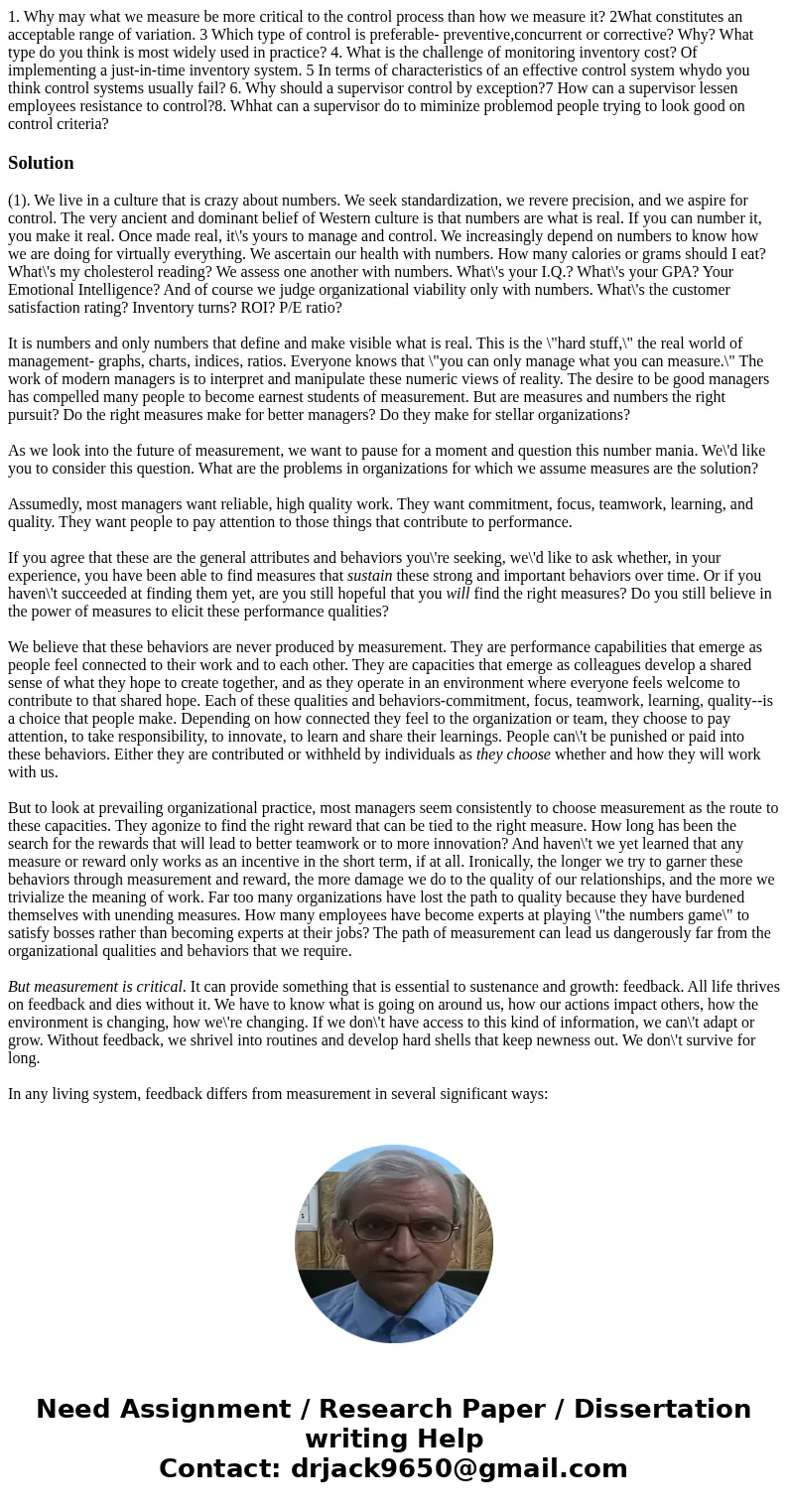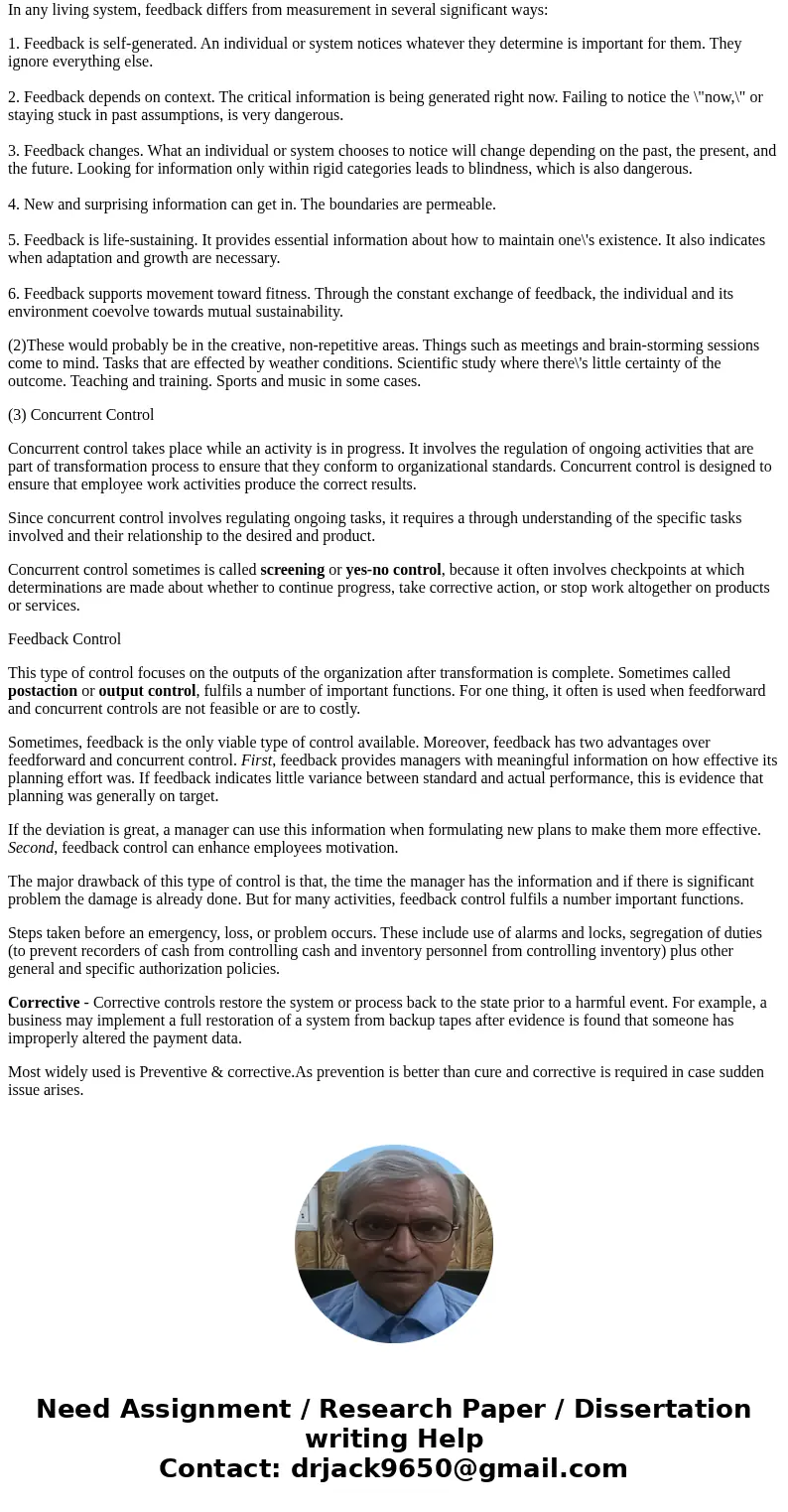1 Why may what we measure be more critical to the control pr
1. Why may what we measure be more critical to the control process than how we measure it? 2What constitutes an acceptable range of variation. 3 Which type of control is preferable- preventive,concurrent or corrective? Why? What type do you think is most widely used in practice? 4. What is the challenge of monitoring inventory cost? Of implementing a just-in-time inventory system. 5 In terms of characteristics of an effective control system whydo you think control systems usually fail? 6. Why should a supervisor control by exception?7 How can a supervisor lessen employees resistance to control?8. Whhat can a supervisor do to miminize problemod people trying to look good on control criteria?
Solution
(1). We live in a culture that is crazy about numbers. We seek standardization, we revere precision, and we aspire for control. The very ancient and dominant belief of Western culture is that numbers are what is real. If you can number it, you make it real. Once made real, it\'s yours to manage and control. We increasingly depend on numbers to know how we are doing for virtually everything. We ascertain our health with numbers. How many calories or grams should I eat? What\'s my cholesterol reading? We assess one another with numbers. What\'s your I.Q.? What\'s your GPA? Your Emotional Intelligence? And of course we judge organizational viability only with numbers. What\'s the customer satisfaction rating? Inventory turns? ROI? P/E ratio?
It is numbers and only numbers that define and make visible what is real. This is the \"hard stuff,\" the real world of management- graphs, charts, indices, ratios. Everyone knows that \"you can only manage what you can measure.\" The work of modern managers is to interpret and manipulate these numeric views of reality. The desire to be good managers has compelled many people to become earnest students of measurement. But are measures and numbers the right pursuit? Do the right measures make for better managers? Do they make for stellar organizations?
As we look into the future of measurement, we want to pause for a moment and question this number mania. We\'d like you to consider this question. What are the problems in organizations for which we assume measures are the solution?
Assumedly, most managers want reliable, high quality work. They want commitment, focus, teamwork, learning, and quality. They want people to pay attention to those things that contribute to performance.
If you agree that these are the general attributes and behaviors you\'re seeking, we\'d like to ask whether, in your experience, you have been able to find measures that sustain these strong and important behaviors over time. Or if you haven\'t succeeded at finding them yet, are you still hopeful that you will find the right measures? Do you still believe in the power of measures to elicit these performance qualities?
We believe that these behaviors are never produced by measurement. They are performance capabilities that emerge as people feel connected to their work and to each other. They are capacities that emerge as colleagues develop a shared sense of what they hope to create together, and as they operate in an environment where everyone feels welcome to contribute to that shared hope. Each of these qualities and behaviors-commitment, focus, teamwork, learning, quality--is a choice that people make. Depending on how connected they feel to the organization or team, they choose to pay attention, to take responsibility, to innovate, to learn and share their learnings. People can\'t be punished or paid into these behaviors. Either they are contributed or withheld by individuals as they choose whether and how they will work with us.
But to look at prevailing organizational practice, most managers seem consistently to choose measurement as the route to these capacities. They agonize to find the right reward that can be tied to the right measure. How long has been the search for the rewards that will lead to better teamwork or to more innovation? And haven\'t we yet learned that any measure or reward only works as an incentive in the short term, if at all. Ironically, the longer we try to garner these behaviors through measurement and reward, the more damage we do to the quality of our relationships, and the more we trivialize the meaning of work. Far too many organizations have lost the path to quality because they have burdened themselves with unending measures. How many employees have become experts at playing \"the numbers game\" to satisfy bosses rather than becoming experts at their jobs? The path of measurement can lead us dangerously far from the organizational qualities and behaviors that we require.
But measurement is critical. It can provide something that is essential to sustenance and growth: feedback. All life thrives on feedback and dies without it. We have to know what is going on around us, how our actions impact others, how the environment is changing, how we\'re changing. If we don\'t have access to this kind of information, we can\'t adapt or grow. Without feedback, we shrivel into routines and develop hard shells that keep newness out. We don\'t survive for long.
In any living system, feedback differs from measurement in several significant ways:
1. Feedback is self-generated. An individual or system notices whatever they determine is important for them. They ignore everything else.
2. Feedback depends on context. The critical information is being generated right now. Failing to notice the \"now,\" or staying stuck in past assumptions, is very dangerous.
3. Feedback changes. What an individual or system chooses to notice will change depending on the past, the present, and the future. Looking for information only within rigid categories leads to blindness, which is also dangerous.
4. New and surprising information can get in. The boundaries are permeable.
5. Feedback is life-sustaining. It provides essential information about how to maintain one\'s existence. It also indicates when adaptation and growth are necessary.
6. Feedback supports movement toward fitness. Through the constant exchange of feedback, the individual and its environment coevolve towards mutual sustainability.
(2)These would probably be in the creative, non-repetitive areas. Things such as meetings and brain-storming sessions come to mind. Tasks that are effected by weather conditions. Scientific study where there\'s little certainty of the outcome. Teaching and training. Sports and music in some cases.
(3) Concurrent Control
Concurrent control takes place while an activity is in progress. It involves the regulation of ongoing activities that are part of transformation process to ensure that they conform to organizational standards. Concurrent control is designed to ensure that employee work activities produce the correct results.
Since concurrent control involves regulating ongoing tasks, it requires a through understanding of the specific tasks involved and their relationship to the desired and product.
Concurrent control sometimes is called screening or yes-no control, because it often involves checkpoints at which determinations are made about whether to continue progress, take corrective action, or stop work altogether on products or services.
Feedback Control
This type of control focuses on the outputs of the organization after transformation is complete. Sometimes called postaction or output control, fulfils a number of important functions. For one thing, it often is used when feedforward and concurrent controls are not feasible or are to costly.
Sometimes, feedback is the only viable type of control available. Moreover, feedback has two advantages over feedforward and concurrent control. First, feedback provides managers with meaningful information on how effective its planning effort was. If feedback indicates little variance between standard and actual performance, this is evidence that planning was generally on target.
If the deviation is great, a manager can use this information when formulating new plans to make them more effective. Second, feedback control can enhance employees motivation.
The major drawback of this type of control is that, the time the manager has the information and if there is significant problem the damage is already done. But for many activities, feedback control fulfils a number important functions.
Steps taken before an emergency, loss, or problem occurs. These include use of alarms and locks, segregation of duties (to prevent recorders of cash from controlling cash and inventory personnel from controlling inventory) plus other general and specific authorization policies.
Corrective - Corrective controls restore the system or process back to the state prior to a harmful event. For example, a business may implement a full restoration of a system from backup tapes after evidence is found that someone has improperly altered the payment data.
Most widely used is Preventive & corrective.As prevention is better than cure and corrective is required in case sudden issue arises.


 Homework Sourse
Homework Sourse